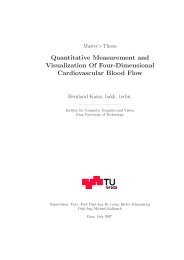CashFlow, A Visualization Framework for 3D Flow - Studierstube ...
CashFlow, A Visualization Framework for 3D Flow - Studierstube ...
CashFlow, A Visualization Framework for 3D Flow - Studierstube ...
- No tags were found...
You also want an ePaper? Increase the reach of your titles
YUMPU automatically turns print PDFs into web optimized ePapers that Google loves.
Related Work2.1. Data <strong>Flow</strong> Models2.1.1 <strong>Visualization</strong> PipelineFigure 2.2: Traditional visualization pipeline: Raw data is processed by a Filter generating derived datathat is mapped to geometric primitives by the Mapper. The Render unit generates the final image.One important concept of scientific visualization is the traditionalvisualization pipeline 1 shown in figure 2.2 proposed in many papers like[IWC + 88][CUL89][WJSL96]. The stages and elements of the visualization pipelineare:• DATAEach stage reads data, processes it and generates new data. Also a stage maycreate intermediate data like gradient in<strong>for</strong>mation per vertex as part of the algorithm,that could also be used by other algorithms as well. Using the visualizationpipeline allows to standardize this intermediate data which either can becomputed on–the–fly or be part of a preprocessing step.This concept also allows optimizing only the parts of the pipeline without affectingother algorithms. When it comes to real–time computation some sections ofthe pipeline may be skipped or the algorithm feeds only parts of the pipeline. Anexample <strong>for</strong> skipping part’s of the pipeline is direct volume rendering, were thehole data set is processed and rendered directly using a transfer–function.Most rendering algorithms can be mapped to this visualization pipeline in aproper way.• FILTERThe raw–data is processed by the Filter object either selecting parts of the dataor resampling the input data to another grid. The Filter object generates intermediatedata which is processed by Mapper or Render objects.• MAPPERThe Mapper object creates new data by applying a certain visualization algorithmto the data. Examples <strong>for</strong> mapping algorithms are applying color to geometricprimitives, creation of textures based on values as well as generation ofGlyphs.• RENDERThe Render object finally creates the geometric representation and combines allrendered images. Filter and Mapper objects feed the Render object. The Renderobject produces OpenGL calls only and does not produce other output data.1 details on <strong>Cash<strong>Flow</strong></strong> visualization pipeline in section 3.1, figure 3.1 on page 38.6





